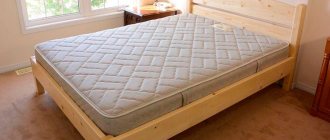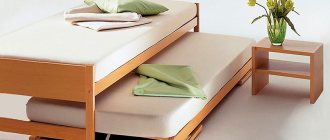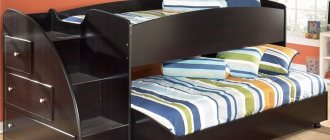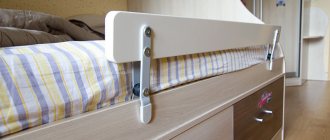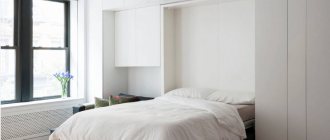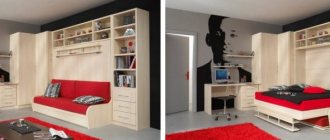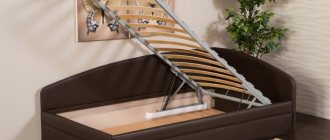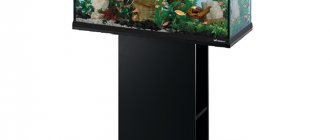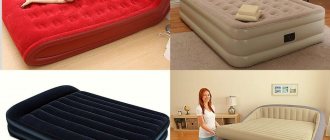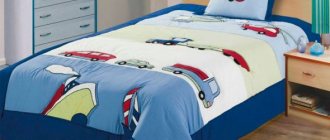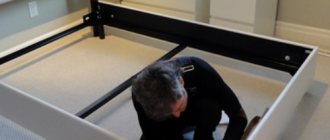When a baby appears in the family, one of the main tasks for young parents is to ensure its safety, including during sleep. To minimize the likelihood of injury at this time, a special protective side for the bed against falls is provided, which can be of completely different configurations. To choose the most functional design, it is worth studying the wide range of models offered by modern manufacturers. If you wish and have basic sewing skills, you can even make such a limiter with your own hands.
Features of using the design
The limiter protects babies from birth to 3–5 years of age from falls, regardless of whether they sleep with their parents or in separate cribs. Older children, and even adults, will also benefit from a side rail, preventing them from falling from the top floor of a bunk bed. Increased safety requirements are imposed on such a sleeping place.
In some cases, a barrier can also be installed on a bed for the disabled to provide safety for people with limited mobility. Such structures must be characterized by increased strength of the material and fastenings in order to withstand the weight of an adult’s body.
In addition to its main function, a bed restrainer can perform additional tasks:
- Protecting the child from drafts. If the bed is placed in a ventilated place or in the direction of the flow of air cooled by the air conditioner, the barrier will prevent the baby from becoming hypothermic. For this purpose, you should choose a model with dense walls.
- Insulation of cold walls adjacent to furniture. In order not to hang wall hangings that have long gone out of fashion, you can insulate the wall with a soft fabric stopper. It would be good if there was foam inside.
- Stylish interior solution. A bed rail, harmoniously combined with the decoration of a children's room, can become the highlight of the room.
When choosing safety barriers for beds, you should pay attention to a number of characteristics: the height of the product, the quality of fastenings, decor and color scheme, thickness and type of insulation. It is also necessary to take into account the child's age, bed size and room design. Particular attention should be paid to the quality of the materials used to manufacture the limiter. Products for children must undergo certification confirming that the product is safe for health, and its characteristics are verified by special tests.
Types of limiters
Based on the fact that a bed rail can be used in a variety of cases, for different categories of users, and can also be installed on different types of beds, there are a huge number of product varieties. To correctly choose a functional and reliable protective board, you should understand the features of each type.
Bed guards against falls can be classified according to several characteristics: products differ from each other in the type of material, method of fastening and design.
By material type
Bed restraints are made from a variety of materials. He can be:
- soft;
- mesh;
- plastic;
- wooden.
Pros and cons of transformable children's beds, popular designs
For the youngest children sleeping in a separate place, soft sides are ideal. Such restraints for a child's bed are made of foam rubber, thick enough so that the baby does not hit the hard bars of the partitions while sleeping. As a rule, such products are equipped with one or more fabric capes. The removable cover can be changed and washed when dirty.
The mesh side is suitable for older children or those babies who sleep with their parents. Protective barriers for children's beds made of mesh are a plastic or metal frame with fastenings, on which an elastic fabric or plastic mesh is stretched. The undoubted advantage of such a board is its breathability. In addition, such a barrier for the bed does not prevent the child from seeing everything that is happening around him in the room. The mounting method on such devices is, as a rule, universal and allows you to hang the fence on any type of furniture.
When constructing a mesh protective barrier for a bed, special attention should be paid to the strength of the material and the reliability of fastening the device to the frame so that the child cannot push through the barrier with the weight of his body.
A plastic side often comes with a bed. This is a ready-made design with a removable or non-removable fastening. The advantage of the product is reliability and high protective properties. The thickness of the plastic used to make the barriers will not allow even an older child to break through it in his sleep and fall to the floor. In addition, this is a fairly soft material, so additional covering of the structure with fabric and a softening layer is not required.
A factory-assembled functional children's bed is most often equipped with wooden sides. The second tier is subject to increased safety requirements, so even if a teenager sleeps there, the furniture is still equipped with protective guards, because a fall from a height higher than a child’s height carries the risk of serious injury.
Soft Mesh Plastic Wooden
By mounting method
Protective restraints for beds may also differ in the type of fastening. The designs are:
- with mechanical fastening;
- with fastening under the mattress;
- removable;
- folding;
- stationary;
- with fabric fastening.
Ready-made plastic or mesh barriers are equipped with a thoughtful and reliable fastening system. Most often, devices are mechanically attached to the frame or bottom of the bed using the bolts included in the kit. They may have a folding design, which in the future will allow an older child to climb into bed independently. This functional bed barrier is a reliable choice for safety.
Sometimes the fasteners are screwed only to the side itself, and the other side is simply placed under the mattress and held on by its mass and the weight of the child lying on it. This barrier is easy to install and can be easily removed, but keep in mind that it is not suitable for a baby under 1 year old, since its weight is still too small to hold the side in place.
Stationary fastenings are most often sold complete with furniture; they can especially often be found as part of bunk beds and couches for teenagers. They are securely connected to the berth and are part of its design. Typically, such sides are made of wood or chipboard.
Important nuances of choosing a children's red bed, thematic models
The soft barrier has one of the varieties of fabric fastenings. These can be ribbons, ties, Velcro or zippers. Despite the apparent weakness, this fixation is quite reliable. It is only important to pay attention to the quality of the seams and threads.
With mechanical sealing
With fastening under the mattress Removable Folding Stationary With fabric fastening
Mounting options
There are several options for attaching a handrail to enclose a child's bed. Purchased protective systems are often equipped with a reliable fastening system, which allows you to attach the side to the base of the bed, side walls, or secure the installation using metal structures under the mattress. Such designs involve holding the side with the weight of the sleeper himself.
The metal frame is placed under the mattress, and a protective edge is attached to it in a vertical position. Thus, thanks to the body weight of the sleeping person, the side is held in a vertical position. This installation is not suitable for protecting children under two years of age. Their body weight is too small to support the metal structure under the mattress.
When choosing the option of how to make a mount for a bed restrainer with your own hands, you should take into account the weight of the protective system, the weight of a sleeping child, the need for the structure to be detachable, and the stationary use of the side.
When using one barrier for several horizontal surfaces intended for children's sleep, you should use a mount that can be installed on both horizontal and vertical surfaces, which will allow it to be installed on any bed. Such fastenings can be purchased either complete with protective systems or separately from them. If the protective system is installed on a crib in which the child always sleeps, you can attach the barrier to the base of the bed using screws and brackets. In this case, it will not be possible to remove the protective wall, but the child will be under reliable protection.
Choosing the appropriate height and side size
The height and size of the sides should be selected based on the child’s age and degree of mobility in order to ensure the baby’s safety not only in sleep, but also during active games in the bed.
| Child's age | Types of activity | Side height, cm | Item size |
| 0–6 months | The child lies in the crib, turns over, sits up, tries to crawl | 30–40 | Full length of the bed |
| 6 months - 1 year | The child gets up in bed, holding onto the railings, actively crawls, tries to climb over the sides | 70–90 | Full length of the bed |
| 1–3 years | The child stands confidently on his feet, walks, gets in and out of bed independently | 20–30 | Full length of the bed |
| 3–6 years | The child gets up and lies down independently; the bed can be in a room separate from the parents’ bedroom | 20–30 | Partially covers the long edge of the bed |
| Second tier of bed regardless of age | — | Approximately 20 cm | Full length of the bed |
The height of protective barriers should also be chosen based on the child’s motor activity. The maximum value should occur at a time when the baby is still unsteady on his feet, but already wants to actively explore the world - he stands up in the crib, holding on to the sides, and tries to get out of it, crossing his legs. It is between the ages of 6 months and a year that the risk of injury from falling out of bed increases several times compared to any other age. A high side is necessary so that the child does not fall when trying to climb over it.
Borders for children's beds - 50 photo ideas:
PreviousBedsChildren's beds from 2 years with sides
Next
BedsIkea children's bed for children from 3 years old
Colors and decor
Among the variety of decorative options for bed restraints for children, everyone can easily find the perfect one for themselves. There are several nuances that will help make the choice easier. Modern psychologists unanimously claim that the younger the child, the more important it is for him to have different colors, patterns and details in his sleeping area. Looking at them every day, the baby develops vision, perception of color, size and perspective. Therefore, it would be a mistake to purchase monochromatic designs - it would be better if they had a small print of delicate pastel colors.
Traditionally, pink interior items are chosen for girls and blue for boys. This is an optional rule. Combinations of simple colors in soft shades look good - blue and yellow, green and pink.
An older child’s room or corner can be decorated in simpler shades, repeating the color scheme of the nursery’s interior. It’s good if it reflects the baby’s character or his hobbies. For a comic book lover, you can choose models with superheroes depicted on them, and for a young car collector, you can choose a racing track.
Features and types of children's corner beds, their dimensions
When choosing a design option, it is important to pay attention to the properties of colors. So, yellow lifts the mood, green calms, and orange excites the psyche. In any case, it is recommended to refrain from an abundance of such active colors as black or red, or introduce them very carefully, with small color accents.
Future product design
Before you begin, you need to decide what kind of protection you will sew. All factors must be taken into account.
Size
What kind of bed will you sew for (rectangular, round, oval). The length, width or circumference must be measured and recorded. We decide on the height of the sides. Basically it is 30-40 cm. How will the protection be located? Around the entire perimeter of the crib, on one side or two, three. Based on these parameters, we will calculate the material consumption.
Type of sides
There are a lot of photos of crib bumpers on the Internet. But you need to rely not only on your preferences or on the picture, but also on the characteristics of soft protection:
- universal (for example, a bumper is a pillow, which can later become an additional decor on a sofa or as a toy);
- shape (round, oval, square, rectangular);
- height: high or low (braid, roller, snake);
- functionality (the covers will be removable or not);
- multi-component (consist of several parts or solid sides around the perimeter of the crib);
- figured (in the form of little animals, stars, houses, etc.).
Color solutions
Based on the gender of the child (for a girl - pink tones, for a boy - blue shades). Or on the color scheme of the room.
IMPORTANT! Do not use textiles of bright or dark colors to protect the crib. They will excite the baby's visual perception. White color is not advisable - not practical!
Neutral shades are suitable. A beautiful print (flowers, animals, cars, etc.) will cause additional interest for the baby.
Side decor
For decoration, you can use ribbons, ruffles, and felt appliqués.
IMPORTANT! Under no circumstances should you use small parts (buttons, rhinestones). We SEW all the details, not glue. We also try not to use too many decorative elements. Baby's safety comes first!
Today there are a huge number of pictures on the Internet with various options for protective bumpers. If your imagination has left you, you can find photographs of crib bumpers that suit your taste.
Note!
DIY furniture made from pallets (140 photos) - step-by-step master class with diagrams and drawings, design ideas
DIY coffee table - manufacturing guide with a full description of the steps, choice of materials (120 photo ideas)
Do-it-yourself laundry basket (130 photo ideas): step-by-step master class for making it yourself, choice of materials, design options
Choosing material
The quality of soft protection depends on the fabric. In order not to cause an allergic reaction in the baby, we choose material from natural fibers.
Textile. We settle on soft and tactilely pleasant. Natural dye. Ideally, satin, poplin, calico, flannel, linen, flannel. Pay attention to the location of the pattern, the density and width of the fabric in the roll (the latter varies from 110 cm to 220 cm). This is important for calculating the amount of fabric. Don’t forget that cotton shrinks after washing, so you need to buy extra fabric.
Filler. In this case, it is better to give preference to synthetics. Common materials: synthetic winterizer, foam rubber. These fillers tolerate washing well and do not lose their shape.
IMPORTANT! Stuffing the bumper with down, cotton wool or wool is strictly prohibited! They can cause allergies, and they are not washable. The choice of filler depends on the design of the product or its shape. You can use mixed types of stuffing, this will allow you to create interesting shapes and volumes of products.
Fastenings. Quite an important point. Rope, tape and Velcro will do. It is better not to take the option with buttons, because... a child may tear one of them off and swallow it. Ribbons and strings must be tied securely, without leaving hanging ends at the knots, so that the baby does not untie them and get tangled.
Note!
- Do-it-yourself illuminated mirror - step-by-step master class on how to make it yourself, photos of types of lighting
- DIY flower stand - TOP 100 photos of stand options, detailed instructions, diagrams and drawings from the masters
- Do-it-yourself furniture restoration: restoration methods, step-by-step master class, necessary tools and materials
Additional accessories. Once you decide on the design, choose what additional materials you will need: zippers, felt appliqués, lace, etc. Inspect the items carefully. There should not be any fragments on which the child could be scratched.
The best manufacturers
The market for barriers for children's beds is represented by many manufacturers. User experience allows us to highlight several trusted brands:
- Lindam is a well-known brand from the USA that produces folding mesh bed barriers. It is distinguished by high quality and a well-thought-out fastening system.
- Ikea is a famous Swedish brand that traditionally produces a wide range of products for children, including removable soft sides in cribs for newborns.
- Baby Safe is a Chinese brand widely represented on the Russian market. Mainly produces mesh barriers.
- Leader Kids is a domestic manufacturer of textiles for children. It is distinguished by a variety of prints and colors, and the high quality of the raw materials used.
- Sweet Baby is a joint Russian-Italian production. The assortment includes a variety of models of fabric bumpers and pillows in trendy colors. High-quality natural fabrics are used in production.
To ensure that the model perfectly matches your personal preferences and needs, you can make the protective rim yourself.
Lindam Ikea Baby Safe
Leader Kids Sweet Baby
How to make it yourself
Despite the variety of finished products, it will be easy for handmade lovers to make a bed restrainer with their own hands. Made by hand, it will reflect the individual taste of the creator, and in terms of functionality it will not be inferior to factory models.
For those who are comfortable with a sewing machine and an overlocker, it will not be difficult to understand how to make a soft barrier for a bed. During the work you will need:
- foam;
- fabric for making covers;
- zipper;
- threads, pins, needles, scissors.
When all the necessary materials are prepared, you can begin manufacturing. The design of the soft sides is so simple that it does not require a pattern.
- First you need to cut the foam rubber to the internal size of the sides of the bed. You should get 4 parts - 2 narrow (for the ends) and 2 long.
- Next, blanks for covers and ties should be cut from chintz or calico. For covers, the fabric should be wrapped around the foam element, mark 2 cm on each side for the seams and cut off.
- Sew a “bag” from the resulting cuts, stitching the seams on a machine.
- Sew a zipper into the remaining unstitched short side of the pillow.
- At the end, turn out the resulting covers, put them on foam blanks, and attach the finished structure to the crib.
Experienced craftswomen can add frills made of contrasting fabric to the pillows; they are sewn into the seams of the covers.
Bed bumpers are a very useful device that provides maximum safety and comfort to a sleeping child. In addition, they are a stylish addition to the interior of a nursery, which is why the product is very popular among parents of babies.
